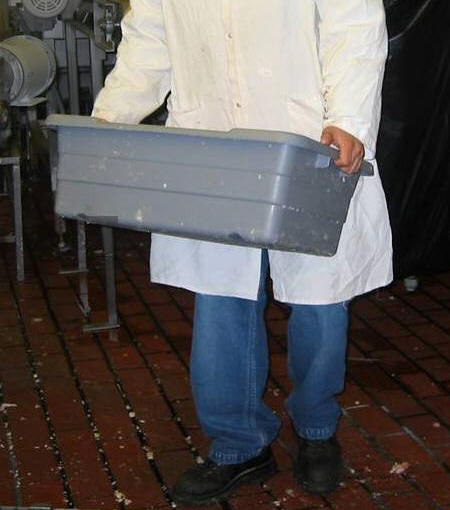 |
 |
| Carts can eliminate heavy carries | |
 |
 |
| Good carts, as appropriate for their need (see below) | |
Principles affected
Related pages
Material handling
Alternatives to carts
Moving heavy carts
Workstations
Background
Carts are one of the basic strategies for improving manual material handling. There are countless varieties available on the market, and additionally, carts can easily be customized or fabricated in-house. Usually the issue is picking the right type of cart for the task at hand. Common problems include inappropriate height, inadequate clearance to reach and grasp materials, wheels that are too small, and lack of a good handle.
(See comments on terminology below)
Objectives
The cart design should allow good access to the material being handled, specifically (a) be at a proper height to minimize the amount of bending or lifting, and (b) provide good clearance to easily reach and grasp materials. Carts should be sufficiently maneuverable and easy to push. Most carts require some type of handle, which should be compatible with the hand and at a good height for handling.
Ideas and Options
The following overview provides a range of options for carts. Selection depends on the type of material being handled and the locations it is being moved to and from.
Fixed height
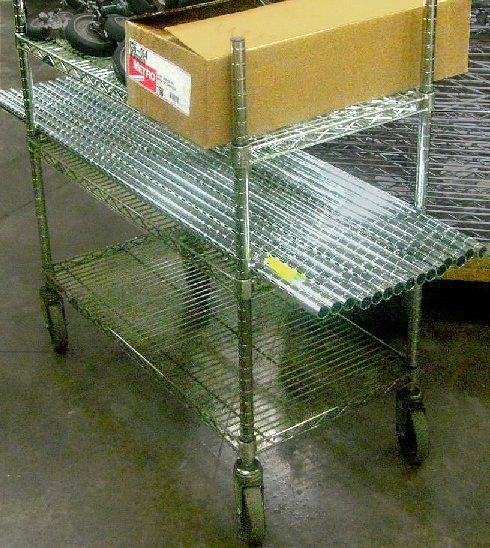 |
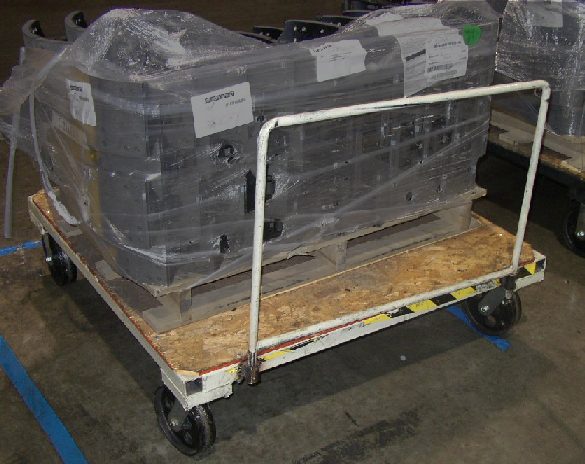 |
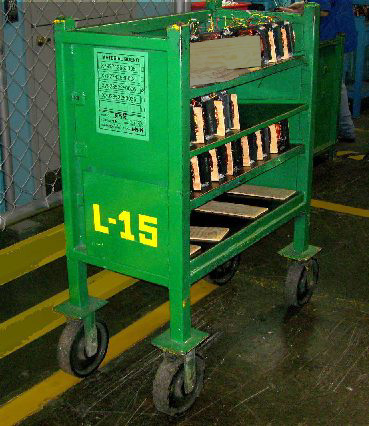 |
| Easy-to-customize cart (www.metro.com) | Wide cart to hold complete pallet | Heavy duty cart |
Fixed-height carts are simple, inexpensive, and can be very effective — if they match the task at hand. (See comments below on common problems with carts.)
Adjustable-height — scissors lift style
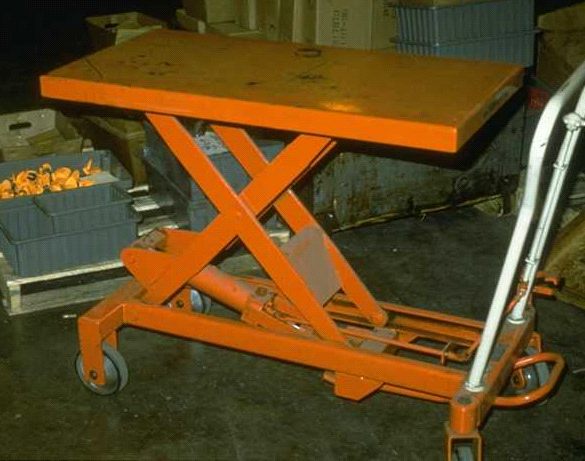 |
 |
| Manual pump to change height | Powered height adjustment |
A large number of carts are height adjustable, commonly using a scissors-lift mechanism with a manual pump incorporated into the handle, as shown above left. These styles can be powered and/or tiltable (right, www.vestilmfg.com).
Powered versions are generally easier and faster to operate than the manual pumps, which makes them preferable for high volume production and/or handling multiple layers of materials. The manual pumps are less expensive and best used in situations where the height does not need to be changed frequently.
Adjustable-height — mast style
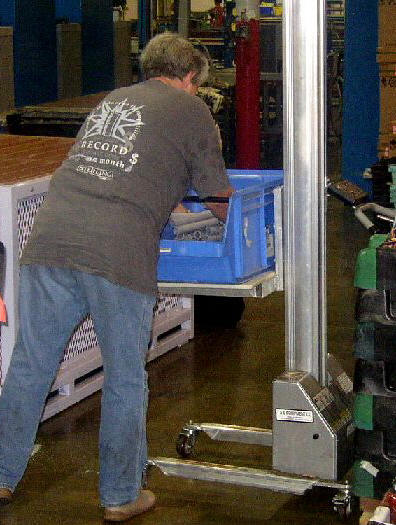 |
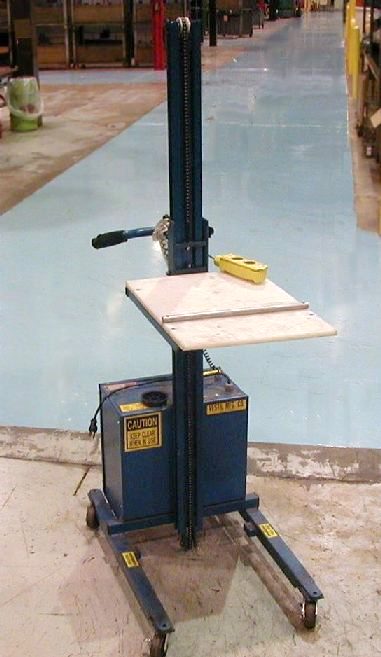 |
| Mast style carts | |
Mast-style carts typically provide greater height adjustment than other styles of carts, often 6-10 ft. Additionally, they can be lightweight and maneuverable, making them easy to manually push and position.
Because the full array of these devices can combine the functions of a cart as well as a lift and are not easily classified into either of these categories, they are treated in a separate category lifter-transporters, which contains more information and examples.
Adjustable height — spring-loaded
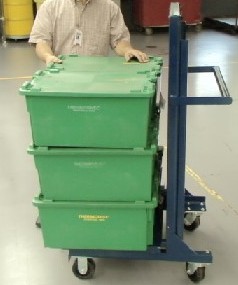 |
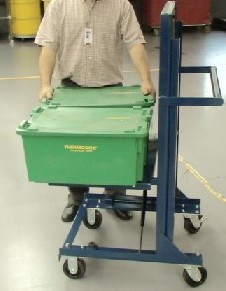 |
| As loads are removed or added to the cart, the spring adjusts so that bending is minimized (www.ergocart.com) | |
A relatively new type of cart incorporates coil springs to raise and lower the surface as materials are added or removed. Compared to powered adjustable carts, spring-loaded carts are generally lower cost. The springs cannot adjust the surface with precision like the other adjustable carts listed on this page, but when used appropriately, can still be very effective in reducing the amount of bending to lift the loads.
Generally, spring-loaded carts work better with heavier loads. Springs can be added or removed to enable use with different weights of items being handled.
Adjustable height — die carts
 |
| Small die cart |
The original purpose of die carts was to lift heavy dies into stamping presses. Because the dies are so difficult to lift, these adjustable carts were developed in order to slide the dies into position, using a hydraulic cylinder and foot pump to attain whatever height is needed.
Since these carts are so sturdy and have the height adjustment feature, they are helpful in a wide variety of additional applications. (See die cart used as workstation.)
Conveyor or slide surfaces
 |
 |
| Cart height at exactly the same height as the conveyor, with removable conveyor stop on open end | Similar cart, but with steel bar surface rather than rollers to slide the load |
Conveyor surfaces are often helpful on carts to help transfer heavy loads. The height of the cart should be exactly the same height as the fixed conveyor. Loads usually need to be secured, such as with a conveyor stop.
A slightly different option is to use a sliding surface instead of rollers. This approach is lower cost and somewhat more durable, but requires more force to transfer the load. Steel is often used as the surface, but other slippery material such as polypropylene or high molecular weight polyethylene (HMWPE) can be used. Again, the heights of the cart and the fixed conveyor should be exactly equal.
Whether using a conveyor or a sliding surface, the goal is to slide the material as much as possible rather than lift. (See slides.) This approach does not apply equally well when stacks of items are handled.
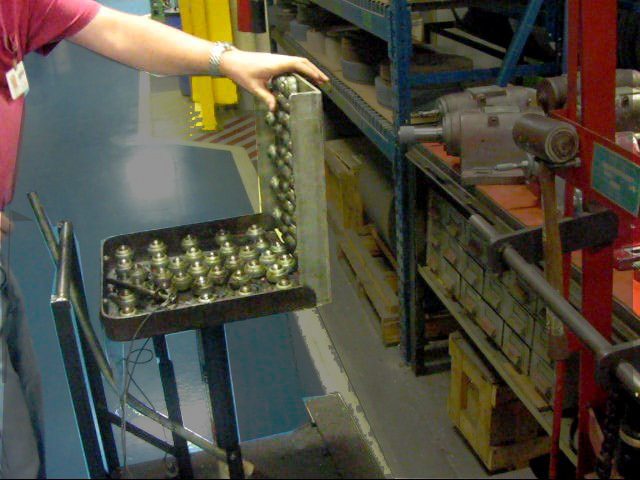 |
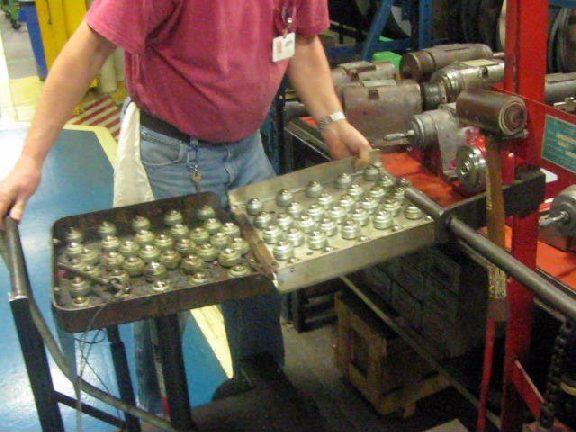 |
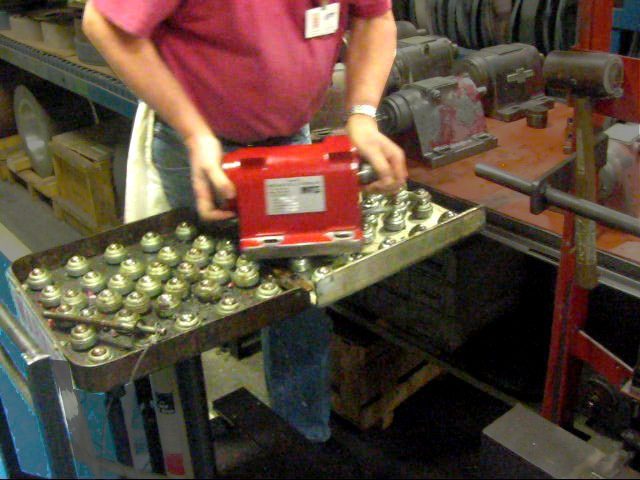 |
| Adjustable-height die cart with roller ball conveyor surface and drawbridge used to transfer heavy items from storage rack | ||
Drop down sides
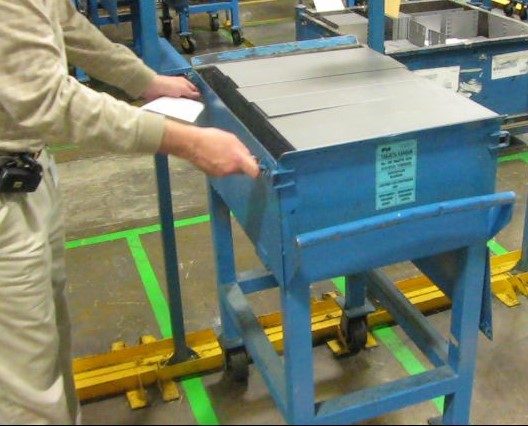 |
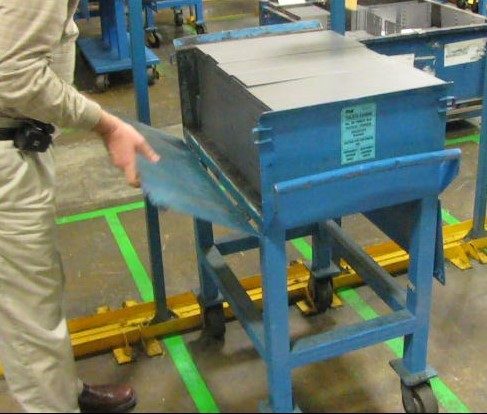 |
| Drop-down sides (note the fixed height at waist level) | |
Materials on carts should be as accessible as possible. Drop-down sides provide a relatively low cost technique for providing good access.
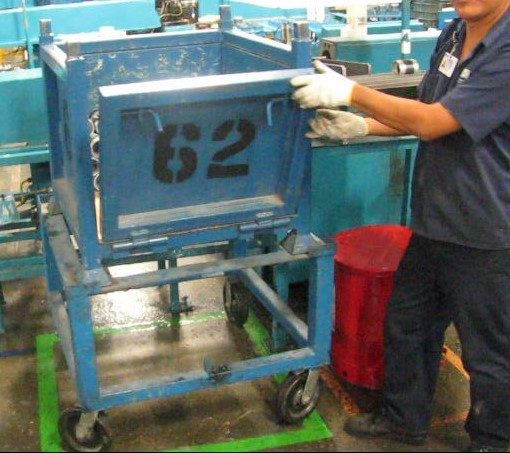 |
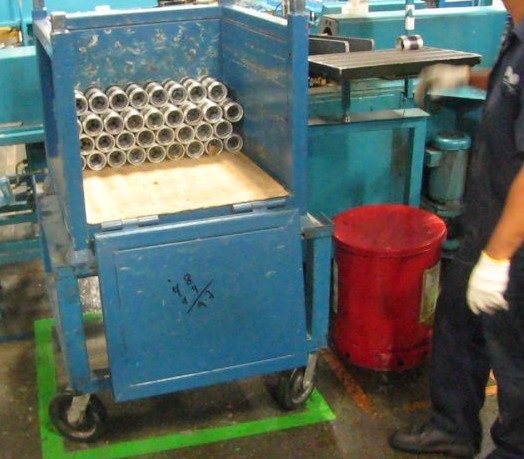 |
| Drop-down sides on heavy-duty cart for larger, heavier materials | |
The photos above show two carts that are homemade and customized for handling two different parts. Both incorporate several excellent features: (1) roughly waist height to minimize bending and reaching overhead, (2) drop-down sides facilitate easy loading and unloading, 3) large wheels, and (4) a sturdy base.
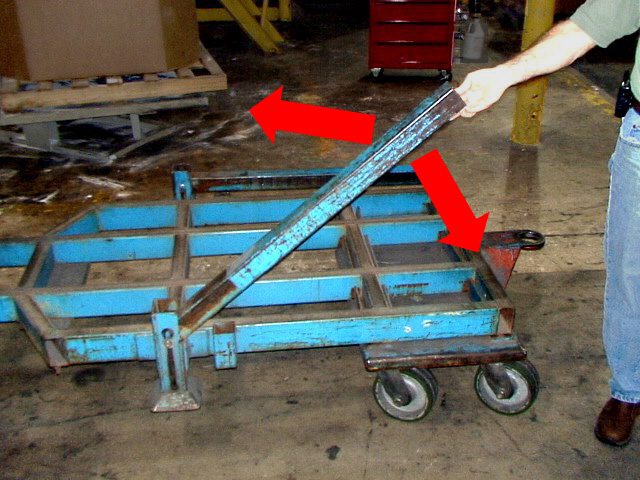 |
 |
| Drop-down posts — At right, posts in up position (materials are long sections of steel; note also dual wheel system) | |
A variant of the drop-down sides is a drop-down post system, used for large objects. Completely removable posts are often used, but the drop-down style has two excellent advantages: (1) it is not necessary to lift the full weight of the post (which can be substantial with heavy-duty carts), and (2) the post stays with the cart, ready for use, and not susceptible to being misplaced.
A-frame and slant carts
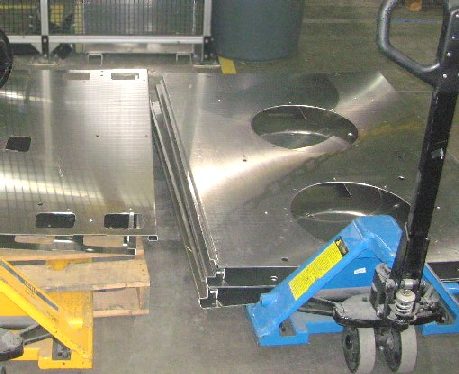 |
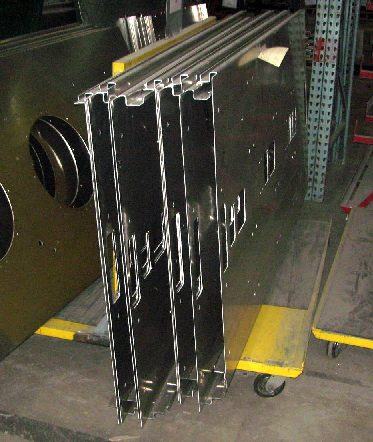 |
| Horizontal orientation — requires bend | Vertical orientation — no bending |
Large flat materials like panels and sheet metal are often handled best in a vertical orientation. If these types of items are placed horizontally, they are usually more difficult to lift, plus sometimes require excess floor space.
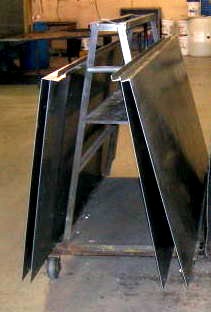 |
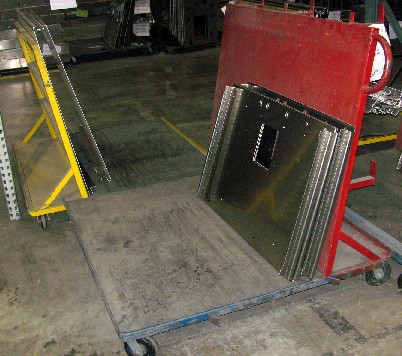 |
| A-frame cart | Slant cart |
Tilter carts
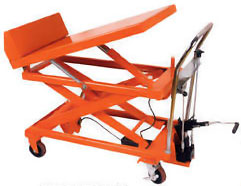 |
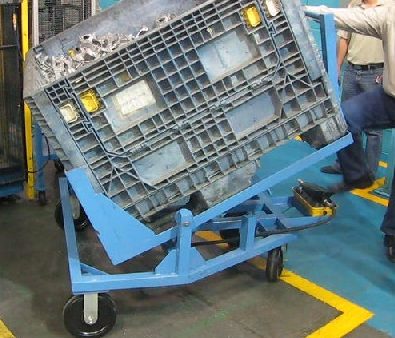 |
| Lift and tilt cart (www.vestilmfg.com) | Homemade battery powered tilt cart |
Tilter carts are often used to provide better access to materials on the cart, especially when containers are being used. (See also tilters.)
Dollies
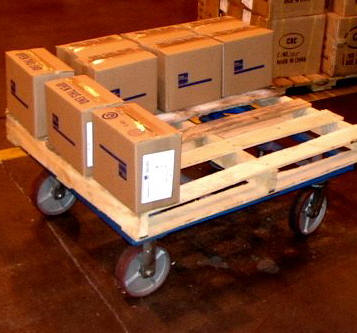 |
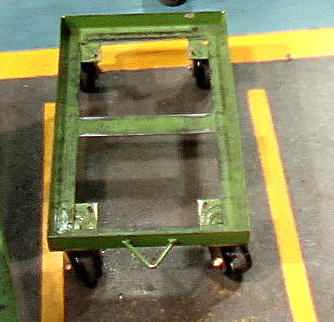 |
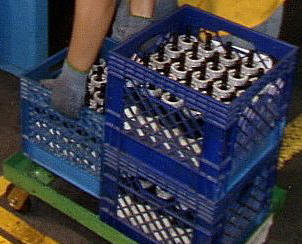 |
| Pallet dolly | Dolly for egg crate containers | |
A dolly is a low level cart without a handle (although terminology can vary). Ideally, the items on the dolly should be tall enough so that it is possible to push against them to move the dolly, without needing to bend over or without needing an extra handle.
Common pitfall: Pushing loads that are routinely too low, requiring bent working posture to handle the dolly.
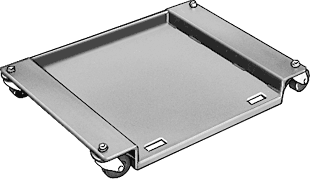 |
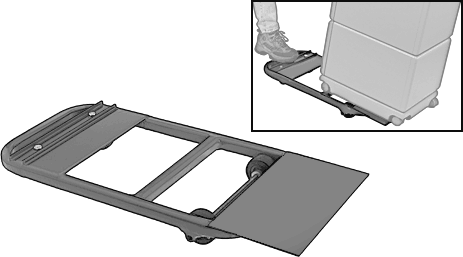 |
| Low profile dolly (www.mcmaster.com) | Tilt and lift dolly (also McMaster) |
As with all styles of carts, there are innumerable types of dollies.
Hand trucks
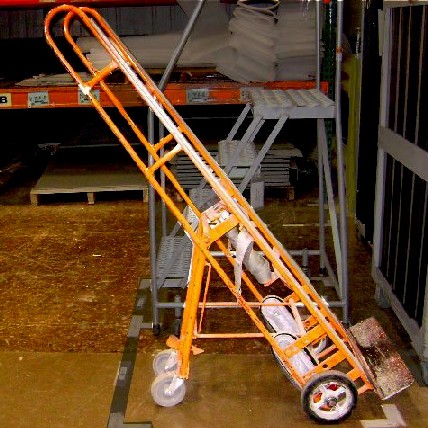 |
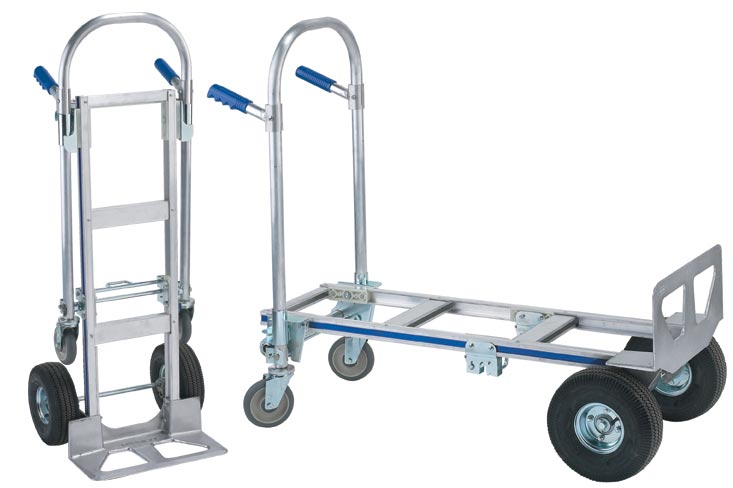 |
| Hand truck with 45° slant feature | Convertible hand truck (www.wescomfg.com) |
Hand trucks are often used for handling tall items like refrigerators or tall stacks of boxes. The long rails of the hand truck provide stability for the upper portions of the load and the two wheels provide excellent maneuverability in tight corners. The load plate at the bottom can be slid under many types of loads so that it is often not necessary to lift items to load or unload. Some designs incorporate additional retractable wheels and slant or horizontal capabilities to increase functionality.
Gurneys
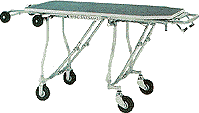 |
 |
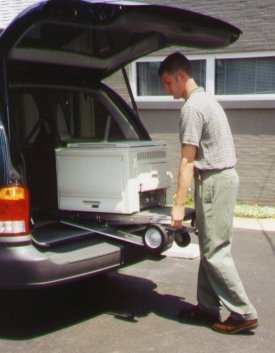 |
| Gurney — raised and collapsed (www.salesmakercarts.com) | Installer loading office product into van using gurney (also Salesmaker) | |
A gurney is a cart with legs that fold up in order to place the whole cart on another surface. Outside of ambulances, the most common use is among customer service employees to transfer loads from vans to pavement level, typically to deliver office equipment. Within manufacturing facilities, the same concept can be used to transport a load, then shift it to a workbench.
Powered carts
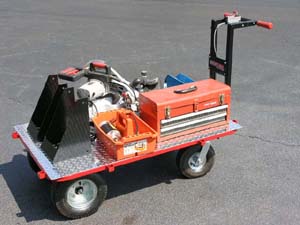 |
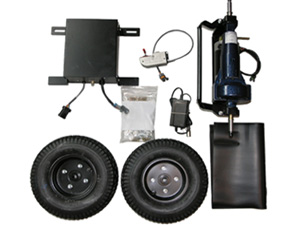 |
| Battery powered cart (www.haulzall.com) | Power train to retrofit any cart (Haulzall) |
Powered carts can be used in difficult-to-access areas or when loads must be routinely moved up or down ramps. Tuggers could also be used, but the integrated power train provides a tidy unit with a small footprint.
Good example: USPS ErgoCart
 |
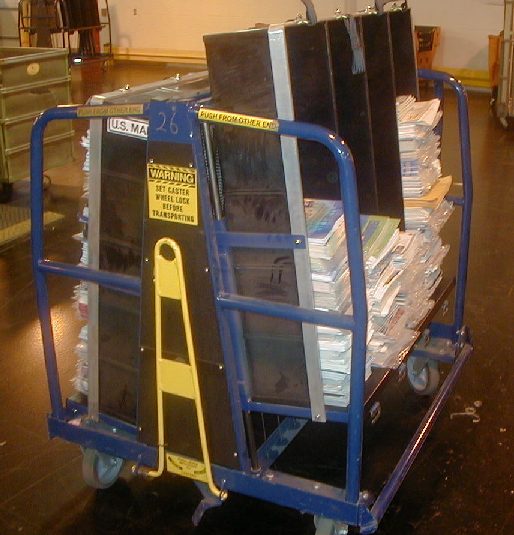 |
| Before | After: ErgoCart |
The ErgoCart above used by the U.S. Postal Service is an example of an exceptionally well-designed cart (developed by www.ergocart.com) that illustrates a number of good concepts. The ErgoCart includes the following features:
- Spring-loaded height adjustment — As mail is loaded into the cart, the holder automatically drops down with the increased weight. Conversely, as the mail is removed, the springs lift the holder up, so whether loading or unloading, the working height is always good. In the photo above left the holder on the far side of the cart is fully loaded and in its lowest position. The holder on the close side is only half-full, consequently, the holder is raised.
- Two sides — The cart is divided into two, so that the holder on each side is loaded separately. Consequently, it is not necessary to reach across the cart to obtain mail; the cart is simply rotated.
- Good handles — The handles provide multiple locations for employees to grip. The diameter of the handles is large so that pressure points are not created.
- Wheels — The wheels are sufficiently large for the weight of the mail, given a floor that is well-maintained. Moreover, the wheels can be easily converted from fixed to swivel (See wheels). The wheel base is wide and stable.
- Coupling — A coupling connecter is included so that two or three carts can be trained together for efficient transportation (pulled by a tow motor, i.e. a powered tugger). The coupling itself is spring-loaded to reduce the amount of bending and the exertion.
Common problems with carts
Height and access
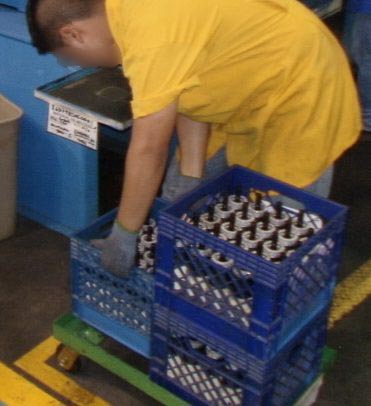 |
 |
| Too low | Too hard to reach |
A common problem is that the type of cart being used is not appropriate for the task, such as shown in the photos above where the carts are too low and the materials difficult to access (especially in photo above right). Sometimes the best solution is using a completely different cart. In other cases, the carts can be modified, as with the following example.
 |
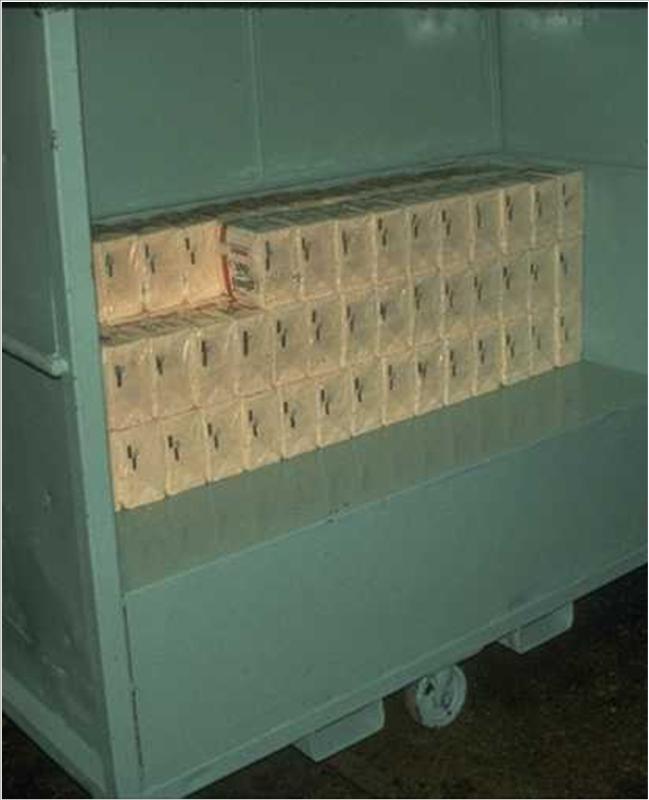 |
| Before: Too low | After: False bottom added to raise height |
A relatively easy way to adapt existing carts to improve working height is to add a shelf or false bottom to low carts. The goal in this case is to keep materials at least above knee height. Adjustable-height carts are generally better, but often simply adding the shelf as shown above can provide good benefit at a low cost.
Wheel size
 |
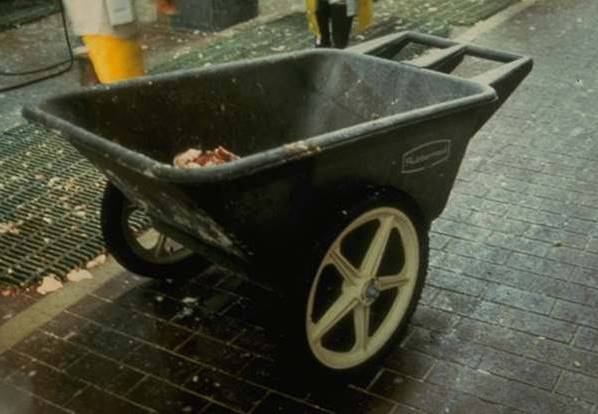 |
| Heavy push: wheels too small, rough floor, no handle | Easier push: large wheels, good handle |
The photo above left shows a very heavy push, as indicated by the extent to which the employee has to lean in order to push the cart. A closer look shows that the wheels are far too small and the floor too rough. The cart above right has much larger wheels and the floor is much smoother. (See wheels. Also see lift trucks and pushers and tuggers for carts that are too heavy to be pushed manually.
Handles
Also in the photo above left, there is no particular place for the employee to grip the cart. Note especially that the absence of a handle puts the wrists in a bent position with all the force pressing against the sensitive tissue in the palm of the hand. The photo above right has a much better handle. Good handles can be designed into the cart or sometimes retrofitted, as shown below.
 |
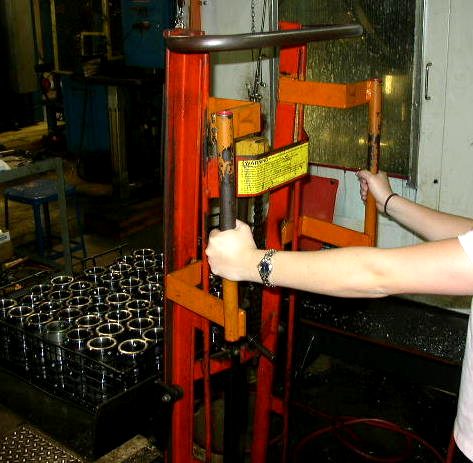 |
| Vertical grips that accommodate different height people | Retrofitted vertical grip |
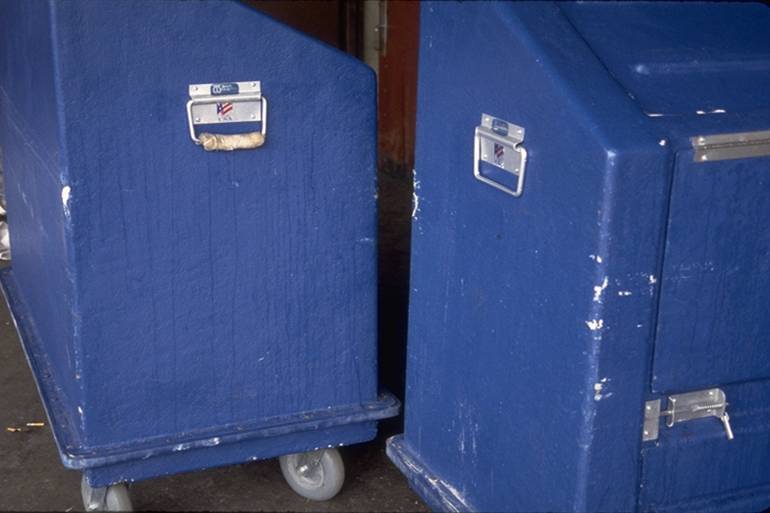 |
| Thin handles, one wrapped with tape |
Many handles are too thin, which creates pressure points on the hands when pulled. Wrapping the handles with tape is a good quick fix, but ideally should be replaced with grips of larger diameter.
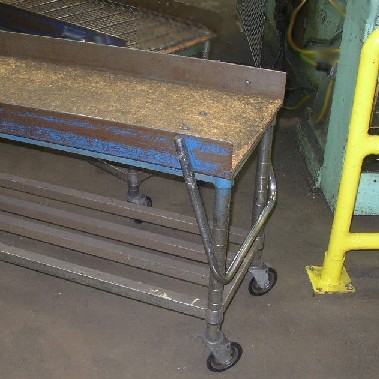 |
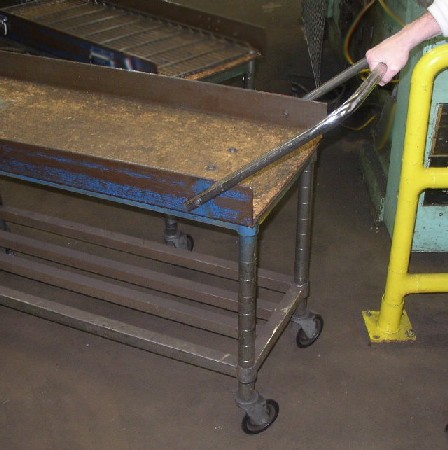 |
| Homemade cart with good handle that drops out of way when not in use | |
Visibility
| Poor visibility |
On occasion, loads can be too high to permit good visibility. In this case, typically another style of cart should be used.
Leg clearance
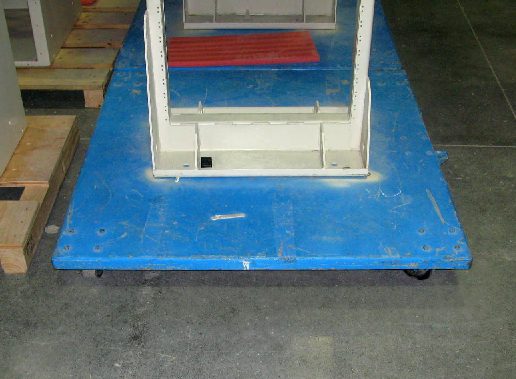 |
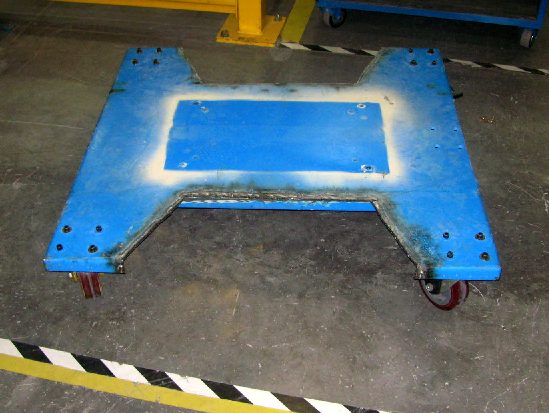 |
| Before: No clearance for legs | After: Leg clearance cut into dolly |
Another problem that can occur occasionally is lack of sufficient clearance for legs, which can create long reaches and awkward working postures. As shown in the example above (for a dolly used as a base for the assembly of large electrical boxes), it may be possible to make cutouts to create sufficient leg room.
Flooring
One of the reasons why floors need to be kept in good repair is to facilitate the use of carts and other wheeled devices. Rough floors make it harder to move the carts, especially when hitting a particularly large crack or hole.
Push vs. Pull
Normally, it is better to push rather than pull a cart, for two reasons: (a) you are generally stronger pushing rather than pulling, and (b) if you slip and fall, the cart is much less likely to roll over you.
Additional
Terminology
Common usage in North America mixes the terms “cart,” “dolly,” and “hand truck.” In particular, “dolly” and “hand truck” are used interchangeably. On this page, a “dolly” refers to a cart that is low to the ground without a handle and “hand truck” a two-wheeled device with handles at the top and a single surface at the bottom for supporting the load.
However, the technical definitions are as follows: Hand truck — the generic term for all variations of wheeled platforms used in industry. Floor hand truck (or platform hand truck) — what is commonly referred to in North America as a “cart” and in British English as a “trolley.” Dolly — a low-level flat platform on wheels that does not have a handle. Cart — a two-wheeled platform pushed or pulled by a draft animal or human
See Material Handling Taxonomy developed by North Carolina State University.
More examples
There is no limit to the characteristics and styles of carts, other than your own creativity.
